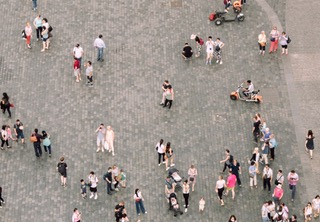Cette publication est également disponible en :
![]() Français
Français

Thesis defended by Hannah Widmer, July 3, 2024 – Institute of geography and durability (IGD).
City dwellers experience diversity in public space every day. In urban spaces, we encounter countless strangers in our everyday lives. As cities are characterized by a diversity of cultural and socio-economic ways of life, these strangers are unknown, on the one hand, and on the other, they are ‘strange’ because they often have a completely different background to us.
In cities, public space plays an important role as a place for leisure, physical activities, mobility, and recreation. It also serves as a space where cultural identity and feelings of belonging to a neighbourhood or another community are created and experienced, for example in the context of celebrations. What should be emphasized specifically is the function of public space as a place of encounter. However, the fact that people are mobile can mean that certain population groups never encounter each other in public space, although they live in a socially mixed neighbourhood. Moreover, encounters with strangers, even if they are only fleeting, are ambivalent: they can be scary or uncanny, on the one hand, but also exciting and inspiring on the other.
This thesis therefore set out to explore the extent of diversity in public squares on the neighbourhood scale, the perception and experience of diversity by users, and the role that the design plays in this. It proposes a conceptual toolkit and an innovative methodology for analysing the use of public squares. Using a mixed-methods approach, the squares Lindenplatz, Hallwylplatz and Idaplatz in Zurich (Switzerland) were analysed. Counting, observations and a survey (n=1,474) were combined with qualitative interviews (n=63) with people who use these three squares in different ways.
The results show that users of the three neighbourhood squares are fairly diverse in terms of cultural backgrounds, social class, ages, level of educational and employment status. The gender balance is even. The design of the squares plays a crucial role for optional activities (meeting family and friends, relaxing, eating, drinking, etc., as opposed to ‘necessary activities’ such as passing through or shopping): the more seating there is in the squares the higher the proportion of people who stay and do not merely cross the squares.
If the diversity of square users is compared to that of the neighbourhood population, it is evident that there is a diversity gap. Diversity in the squares is lower than in the neighbourhood when country of origin, income and education are considered. The mainstream society, i.e. people without migrant background, with an average income, and a tertiary degree are overrepresented in the squares.
People who use the three squares perceive that in the squares, they are surrounded by people who differ from themselves in many respects. However, this is usually experienced as unproblematic and rarely causes them to change their behaviour. If people or certain behaviours are perceived as objectionable, design elements that facilitate freely choosing one’s distance from others (e.g. movable chairs or benches that are positioned in different places and with different orientations) make it easier to live together in the squares.
To encourage encounters between strangers and across difference, the planning of public squares could provide affordances that work for different population groups, e.g. through a variety of ground floor uses, and elements such as water features that are universally appealing. Through appropriate design, these spaces could also offer possibilities to flexibly adapt the distance to other square users and thus promote coexistence in public spaces – regardless of the distance at which it occurs.


